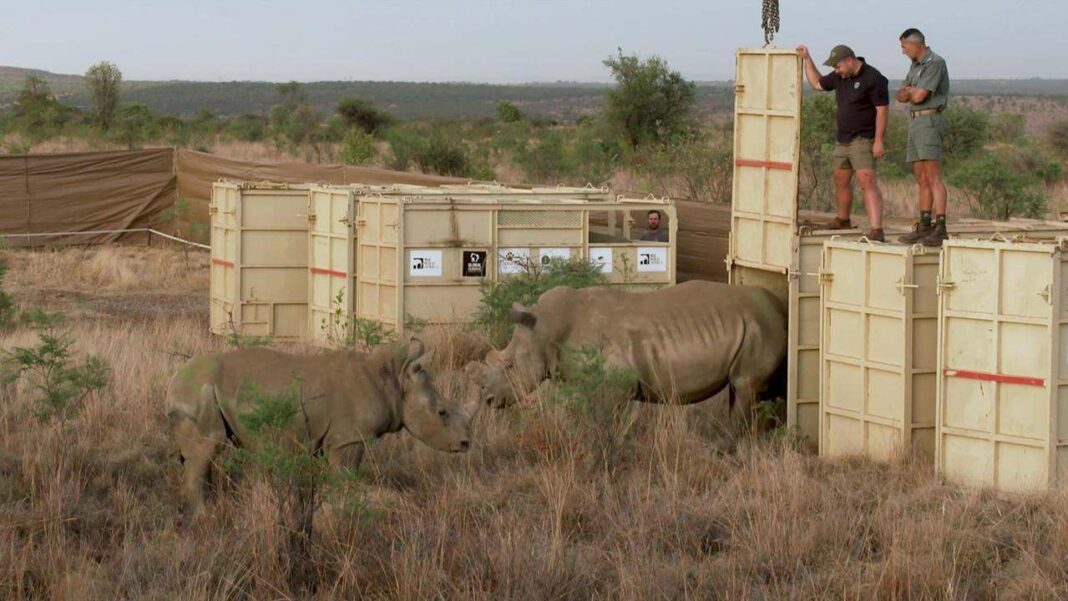Approximately 2,000 rhinos are set to return to their natural habitat in South Africa after years on a private breeding farm. This relocation faces challenges, especially poaching risks. Caretakers are carefully preparing the rhinos for transport, using sedatives to alleviate stress. The exact number of rhinos being released is kept secret to deter poachers. The initiative, overseen by African Parks, aims to conserve the white rhino population and enhance genetic diversity within the Dinokeng game reserve.
After years of residing on a private breeding farm in South Africa, approximately 2,000 rhinos are set to return to their natural habitat. This ambitious endeavor faces the critical challenge of preventing poaching during their transition.
As dawn breaks, the final arrangements are being made at John Hume’s former rhino sanctuary. Transport containers for each rhino are meticulously prepared. Caretakers guide the colossal creatures into the sturdy steel enclosures, securing the doors behind them.
“It’s always a stressful experience when relocating wild animals,” notes Kester Vickery, an expert in heavy animal transport. “To help reduce their anxiety, we’ve administered sedatives to the rhinos, making their journey less daunting.”
Rhinos Making Their Return to the Wild in South Africa
The Exact Number of Relocated Rhinos Remains Confidential
After extensive preparations, the moment has finally arrived for a select group of white rhinos to embark on their journey from captivity to freedom. However, the precise number of rhinos being released remains undisclosed to deter poachers from targeting them.
“We’ve successfully captured all the rhinos and are currently securing the transport containers to the trucks with robust chains to ensure the animals remain safe throughout the journey,” explains Vickery. This intricate operation is not only costly but also risky, given that each rhino can weigh up to 2.5 tons.
To combat poaching, researchers are employing radio technology to safeguard the rhinos.
Excessive Growth of Rhino Population Exceeds Owner’s Capacity
These rhinos originate from the world’s largest private breeding farm, where the population had surged to over 2,000, surpassing the owner’s ability to manage them effectively.
Last year, the conservation group ‘African Parks’ stepped in to oversee the farm and has been systematically releasing the rhinos back into the wild. Project manager Donovan Jooste states, “Our mission is to conserve the endangered white rhino species. They face severe threats from rampant poaching and habitat loss. Our aim is to establish multiple populations to ensure the survival of rhinos for future generations.”
The new sanctuary for these rhinos is located about five hours by truck from the breeding farm, specifically in the Dinokeng private game reserve, which spans 210 square kilometers of grassland and steppe, roughly 100 kilometers north of Johannesburg.
For the first time, a rhino embryo conceived through artificial insemination has successfully developed in a surrogate mother.
The New Residents Are Arriving
Dinokeng is home to the renowned Big Five: lions, elephants, leopards, buffalo, and, of course, rhinos. The introduction of these new rhinos enhances genetic diversity and benefits local tourism, according to park manager David Boshoff.
All rhinos are fitted with tracking devices for continuous monitoring. Some have had their horns trimmed, while others have microchips embedded in their horns to disrupt poaching efforts. Despite being composed of keratin—similar to human nails—rhino horns fetch prices comparable to gold on the black market.
Within the confines of the Dinokeng reserve, these animals enjoy a relatively safe environment; the last poaching incident occurred quite some time ago. Donovan Jooste believes that the rhinos from the breeding farm will quickly acclimate to their new surroundings. “Once we release them into the wild, they’ll integrate seamlessly, as if they have always belonged there.”
This story was reported by Deutschlandfunk on June 12, 2024, at 11:42 AM.
